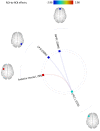Altered Resting-State Network in Adolescents with Problematic Internet Use
- PMID: 36233704
- PMCID: PMC9570959
- DOI: 10.3390/jcm11195838
Altered Resting-State Network in Adolescents with Problematic Internet Use
Abstract
Problematic internet use (PIU) is increasingly recognized as a mental health concern, particularly among adolescents. The resting-state functional connectivity (rsFC) of the triple-network model has been described inconsistently in PIU. Using resting-state fMRI (rsFMRI) and hypothesizing a lower rsFC between default mode (DMN) and central executive networks (CEN) but a higher rsFC within the salience network (SN), this study scrutinized the neural substrates of PIU adolescents. A total of 30 adolescents with PIU and 30 control subjects underwent rsFMRI. The severity of PIU was evaluated by the Internet Addiction Test. Additionally, personality traits as well as emotional and behavioral problems were evaluated by the Temperament and Character Inventory (TCI) and the Strength and Difficulties Questionnaire (SDQ), respectively. Focusing on the DMN, SN, and CEN, we compared rsFC values between PIU and the control. Subsequently, within the combined group of subjects, TCI and SDQ correlation and mediation effects were investigated. Higher rsFC values of the left lateral prefrontal cortex (LPFC(L)) with the left anterior insula (aIns(L)) were observed for PIU than for the control, while rsFCs of the LPFC(L) with the medial PFC (MPFC), LPFC(L), as well as with the right lateral parietal cortex (LP(R)) were lower for PIU. Among these significant group differences, the rsFC between the LPFC(L) and MPFC was mediated by emotional symptoms (standardized β = -0.12, 95% CI -0.29, -0.0052). The dysfunctional attention switching and incentive salience regulated by the SN were implicated as being a neural correlate of PIU, and this relationship would in part be explained by the emotional dysregulation associated with PIU in adolescents.
Keywords: adolescent; emotional symptoms; functional connectivity; internet addiction; resting state; triple-network model.
Conflict of interest statement
The authors declare no conflict of interest.
Figures


References
Grants and funding
LinkOut - more resources
Full Text Sources
Miscellaneous

